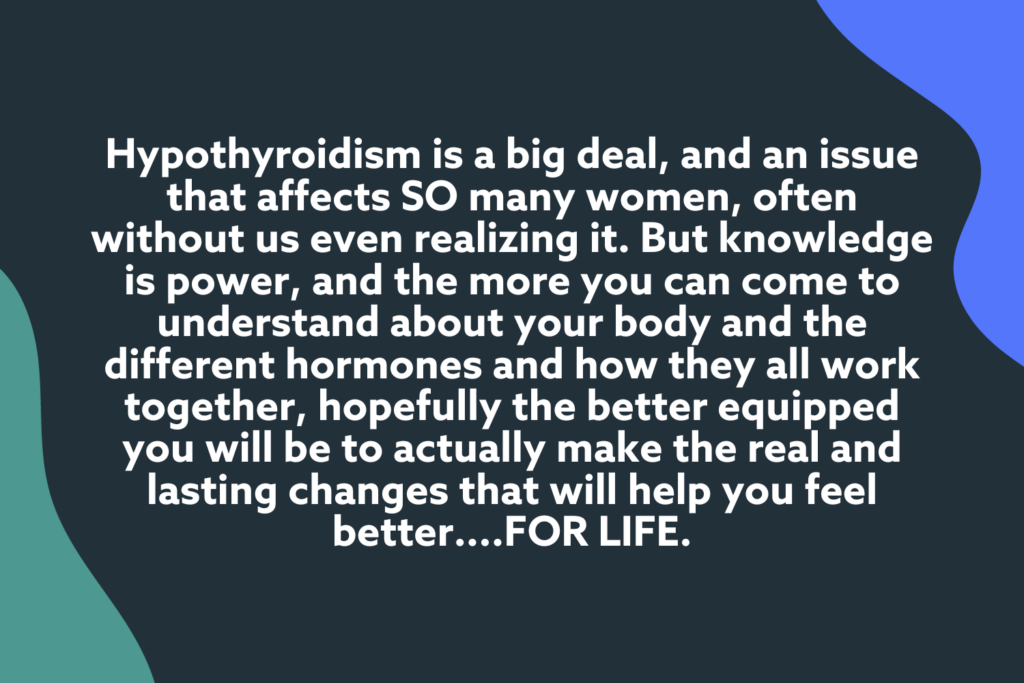It is currently estimated that over 30 million Americans have some form of thyroid disease, and that as many as 10% of women over 40 have a condition known as hypothyroidism, which causes fatigue and weight gain, among other things.
And that means that if you’re a woman over 40 who has been struggling to lose weight, there’s a strong possibility you’ve got a thyroid problem.
So how do you know? And more importantly—what should you do about it?
That’s exactly what this article is going to cover.
Are you ready to lose weight and heal your body for life (without dieting, drugs, or making yourself miserable)?

Our free on-demand video training will walk you through how to make this THE year you set health goals…and keep them.
Of course, as always, anytime we’re talking about medical conditions and specific health issues, we need to start with the disclaimer that what we are going to share with you today is NOT medical advice, and should not be taken as such—it’s just OUR OPINION based on what we’ve learned from doing our own research.
If after reading this article, you think it’s possible that your thyroid could be an issue, then we definitely recommend doing your OWN research, and also connecting with your doctor so that you can get tested and figure out a course of action.

Understanding the Thyroid
So first things first….what exactly IS your thyroid, and what does it do?
It’s actually sort of a trick question, because often when people talk about your thyroid, they are referring to one of two things—either your thyroid GLAND, which is a butterfly shaped gland located at the base of your throat that produces a few different hormones, or the actual THYROID HORMONES themselves, which are normally just referred to as T3 and T4.
And the thyroid gland is important because it’s basically the control center for many of your body’s vital functions—including regulating your metabolism, heart rate, body temperature, and more.
When everything is working properly, the brain sends a signal to the thyroid telling it to produce T3 and T4 hormones as needed in order to maintain a balanced metabolism and keep everything running properly. This process is known as Thyroid Hormone Regulation.
But when it’s NOT working properly—your body is producing either not enough thyroid hormones or too MANY thyroid hormones—that’s when you start to experience serious problems and side effects.
When your body is producing too many thyroid hormones, you’ve got a condition called HYPERthyroidism, where your body—and your metabolism—basically speed up. Your heart beats too fast and your body temperature is too high and you tend to lose weight, or have trouble maintaining your weight.
And while that might sound appealing, this is actually NOT a great thing. Left untreated, hyperthyroidism can be really dangerous.
But while HYPERthyroidism isn’t super rare, it’s also not super common. The more common issue is what we refer to as HYPOthyroidism, which is when your body is not producing enough thyroid hormones.
The current estimate is that somewhere around 10% of women over the age of 45 have some form of HYPOthyroidism. And with hypothyroidism, your metabolism slows down and you start to gain weight—even if you’re still following a healthy diet and exercising regularly.
And of course this is the point where you’re probably thinking, “well obviously this is me! I must have hypothyroidsm.“
And clearly, if this is a condition that affects at least 10% of women our age, then there’s obviously a pretty big chance that this could be playing a factor is your struggles to lose weight and get healthy.
But that still leaves 9 in 10 of us who DON’T have it.

Indicators of a Thyroid Issue
So how do you actually know? Well, let’s talk about some of the main symptoms that tend to indicate a specific thyroid issue:
- Fatigue & Weakness
If you find yourself exhausted all the time—even after a full night’s sleep—this could be an indicator of hypothyroidism. It’s not definitive, but it’s something to look out for.
- Dry Skin
With hypothyroidism, you may notice that your skin feels drier and less elastic than usual—especially on areas like your face, hands, or elbows.
- Feeling Cold All the time
Along those same lines, you may also notice that you’re just COLD ALL THE TIME. Even when it’s warm, you feel cold. You’re constantly grabbing a coat or putting on a sweater even though no one else seems cold.
- Excessive Moodiness
Another common indicator is MOODINESS. If you’re feeling incredibly grumpy or anxious for no reason—especially when it’s out of character for you—then this could be an indication of a thyroid issue.
- Slow Body Functions
Because not producing enough thyroid hormone tends to make your whole body slow down, you may also notice things like sluggish digestion and constipation, as well as a slow heart rate.
- Weight Gain
But if you’ve been struggling to lose weight, even after adopting a low carb lifestyle and implementing a lot of the advice that we advocate for here at Thinlicious or in our TAS program, then this could be a BIG sign that something is off with your thyroid and you may need to visit a doctor to get it checked out.
- Joint Pain
With hypothyroidism, you may start to experience joint pain—especially in your hands and feet—and you may notice SWELLING as well.
- Hair Loss
You may also notice hair loss, which can actually be an indicator of both hyper and hypothyroidism. But with hypothyroidism specifically your hair may start to thin or fall out in clumps—which is obviously concerning and honestly can feel pretty devastating.
- Fertility or Menstrual Issues
And finally, if you’re struggling with fertility or menstrual issues, this could also be an indicator that something’s off with your thyroid. These can include things like longer or more intense periods, irregular cycles, and difficulty getting pregnant.
Now obviously some of these symptoms can be associated with other conditions that we talk about a lot here at Thinlicious—specifically insulin resistance and leaky gut syndrome, both of which are estimated to affect 80-90% of the population. That means that more than likely, your main problem is with insulin resistance and leaky gut, and not specifically HYPOthyroidism.
But if you’ve actually worked on the insulin resistance and leaky gut and you STILL find yourself struggling with any of these issues or symptoms, it might be worth having a conversation with your doctor about your thyroid. They will likely do some tests to get a better sense of what’s going on, like a blood test to measure the levels of thyroid hormones in your body.
And then they’ll be able to recommend a specific course of treatment from there.

Understanding How the Thyroid Functions
But to understand the treatment options, it is also important to understand how the two main Thyroid hormones T4 and T3, actually function in your body.
The T4 hormone makes up about 80% of the total hormones secreted by the thyroid gland. But even though it makes up 80% of your total thyroid hormone makeup, T4 isn’t actually DOING anything because T4 is actually an INACTIVE hormone—meaning that it can’t do much on its own. And that means your body has to convert it into T3 in order for it to actually have any effect, because the T3 is what actually regulates your metabolism, body temperature, and energy levels.
So when your thyroid is functioning properly, it will produce enough T4 and then your body will convert that T4 into just the right amount of T3. This conversion process is actually really important because if too much T4 gets converted into T3, you can experience hyperthyroidism—which comes with its own set of issues and symptoms.
Treatment for Thyroid Issues
Most of the time, the standard course of treatment for hypothyroidism is a prescriptions for Levothyroxine, (sold under the brand name Synthroid), which is a synthetic version of the hormone T4 that our bodies produce naturally.
And so if you get prescribed Synthroid, your doctor will likely test your T4 levels regularly in order to figure out how to adjust your dose, as it can take some trial and error to figure out the right dosage for your specific needs.
But the problem with this standard course of treatment is that Synthroid only addresses the T4 hormone, so it’s not necessarily addressing any underlying issues with T3 conversion. And because your doctor is likely only testing your T4 levels and not your T3 levels, there is a possibility that the treatment may not be fully addressing your thyroid issues.
In fact, a recent journal article by the Yale School of Medicine estimated that as many as 21 million of the current 23 million prescriptions for synthroid in the United States—which in case you’re wondering is almost 10% of the population—may actually be causing more harm than good.
And that means that if you’ve already been receiving treatment for hypothyroidism, or you’ve been prescribed Synthroid, this is definitely something you need to be aware of and looking into, and talking to your doctor about.
Because if you’re taking Synthroid to produce more T4 but your body isn’t actually converting all that T4 into T3, then you’re still going to have all the same problems. It’s not going to help and you’ll still experience all the same symptoms of low thyroid levels. Because you don’t JUST need more T4. You need your body to convert that T4 into T3.
Luckily there ARE other treatment options that can help with T3 conversion and overall thyroid function, and these are definitely worth looking into and worth having a deeper conversation with your doctor about, especially if you’re still experiencing a lot of symptoms even after taking Synthroid.
The first option is actually a treatment that USED to be the standard course of action for hypothyroidism, before the development of synthetic T4. It was known to be VERY effective.
It’s called Natural Desiccated Thyroid, or NDT.
NDT comes from the thyroid glands of pigs and contains BOTH T4 and T3 hormones in a more natural ratio than what our bodies produce.
So naturally it’s easier for your body to convert this into the right amount of T3. It also has other benefits for overall thyroid function and has been shown to have fewer side effects compared to synthetic T4 treatments.
Another treatment option is adding in a T3 hormone supplement, like Cytomel. This helps with T3 conversion and can be used in conjunction with other thyroid medications.
And finally, there are also natural supplements and lifestyle changes that can improve overall thyroid function and help with T3 conversion. These include things like selenium, iodine, probiotics, and stress management techniques.
But at the very least, you should make sure your doctor is looking at the WHOLE picture—not just your T4 levels, but how well that T4 is converting into T3.
Final thoughts
In the end, hypothyroidism is a big deal, and an issue that affects SO many women, often without us even realizing it. But knowledge is power, and the more you can come to understand about your body and the different hormones and how they all work together, hopefully the better equipped you will be to actually make the real and lasting changes that will help you feel better….FOR LIFE.
And so now that you understand a little bit more about thyroid issues, what they look like, and what the potential treatment options are, you’ll be ready to take action as necessary in your own life.
If you think this could be an issue, go get tested. And if you already KNOW this is an issue, or are already taking medication, then , don’t just settle for the standard course of treatment if it doesn’t seem to be working for you. Have a conversation with your doctor about these alternative options and see what might work best for YOU and YOUR body. After all, it’s your health and you deserve to have all the information and options available to you.
Keep learning, keep advocating for yourself, and don’t be afraid to ask questions.
What if you could actually take control of
your health in just 10 days?
It’s not your fault you can’t lose weight as a woman over 40 even though you’ve likely tried literally everything. Your metabolism probably feels broken and your hormones are likely all out of whack.
But you can fix it all with ONE simple change: eliminate sugar. We make it super easy with daily lessons teaching you the science behind what makes us gain weight in our midlife and beyond! Are you ready to get started now?













